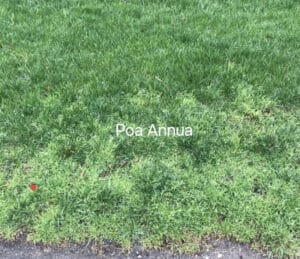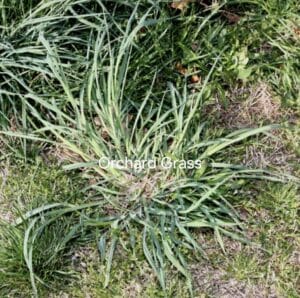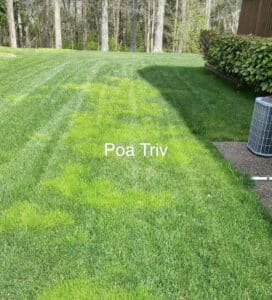Spring’s 3 Most Annoying Grassy Weeds
Poa Annua (annual bluegrass)

Poa Annua, also referred to as “annual bluegrass” is a native annual grass that germinates from September through December each fall. It prefers compacted soil, low areas, and shady areas that have poor soil (against sidewalks, driveways, and road edges). During March and April, it puts out its seed heads that look white from a distance. Once it hits 85 degrees, the Poa Annua dies off. It can’t be prevented from germination or controlled selectively in fescue lawns because it germinates during fescue germination season. It does NOT come from our grass seed. The best way to have less Poa is to aerate and overseed each fall.
Orchard Grass

Orchard Grass is a perennial grass that is native to our soils and is often used in pastures. It grows FAST and TALL in March and April and has a blue/green hue with white stems that look like they are pressed flat from a vise. Once air temps reach low 80s, its growth slows substantially, and it blends in with tall fescue. In other words, you won’t be able to differentiate orchard from tall fescue by May 1st. Orchard grass thrives in yards that have partial shade. The seed comes from our soils. There is ZERO orchard grass seed in our fescue seed blend. Unfortunately, there is no herbicide option to control it without killing the tall fescue.
Poa Trivialis (Poa triv)

Poa Trivialis (Poa triv) or “rough stalk perennial bluegrass” is almost yellow and grows in patches. It spreads by creeping stolons (above ground stems). It has almost zero heat tolerance and goes dormant once temps reach 90, especially in unirrigated lawns. It is almost never an issue in non-irrigated lawns because the summer heat kills it. Irrigated lawns provide just enough water during the heat to keep it alive all year. OVER IRRIGATED lawns have the majority of Poa Trivialis issues! If you have irrigation, make sure you let the soil surface dry out in between irrigation cycles. Try watering really heavily only 2 days a week to reduce your Poa triv issues in 2024! Poa triv will naturally grow slower and darken in May each year, but there is NO selective control that works well to remove it from fescue lawns. There is a growth regulator called “Anuew” that darkens the leaves and reduces the fast growth for about 4-6 weeks. We are currently testing this growth regulator, and if it is successful we will make that option available.
